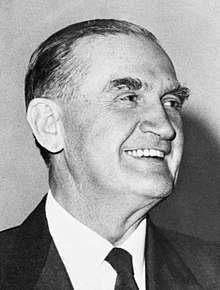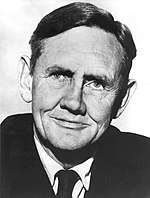Disappearance of Harold Holt
On 17 December 1967, Harold Holt, the Prime Minister of Australia, disappeared while swimming in the sea near Portsea, Victoria. An enormous search operation was mounted in and around Cheviot Beach, but his body was never recovered. Holt was presumed to have died, and his memorial service five days later was attended by many world leaders. It is generally agreed that his disappearance was a simple case of an accidental drowning, but a number of conspiracy theories surfaced, most famously the suggestion that he had been collected by a Chinese submarine. Holt was the third Australian prime minister to die in office, after Joseph Lyons in 1939 and John Curtin in 1945. He was initially replaced in a caretaker capacity by John McEwen, and then by John Gorton following a Liberal Party leadership election. Holt's death has entered Australian folklore, and was commemorated by, among other things, the Harold Holt Memorial Swimming Centre.
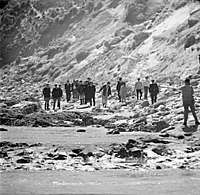 Searchers combing Cheviot Beach after Holt's disappearance | |
| Date | 17 December 1967 |
|---|---|
| Time | approx. 12:20 p.m. |
| Location | Cheviot Beach, Point Nepean, Victoria, Australia |
| Coordinates | 38.3117°S 144.6640°E |
| Participants | Harold Holt, Prime Minister of Australia |
| Outcome | Holt presumed to have drowned |
Background
Harold Holt became Prime Minister of Australia in January 1966, following the retirement of Sir Robert Menzies. He was a career politician, entering parliament at the age of 27 and becoming a government minister at the age of 30.[1] As with Menzies, Holt refused a security detail upon taking office, considering it unnecessary and potentially alienating to the general public. His stance changed after two incidents in mid-1966 – a window in his office was shattered by a sniper, and then an assassination attempt was made on Arthur Calwell, the Leader of the Opposition. Holt grudgingly accepted a single bodyguard for his official duties, but refused any protection while on holiday, regarding it as a violation of his privacy.[2][3] His wife Zara later suggested that this was so he could hide his extramarital affairs.[4]
Holt and the ocean
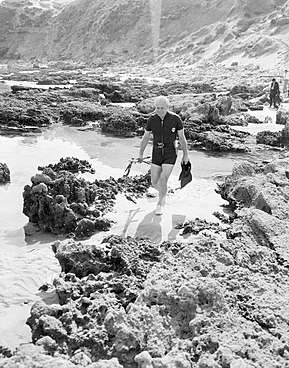
Holt was a keen outdoorsman and had beach houses at Portsea, Victoria, and Bingil Bay, Queensland. He was introduced to spearfishing in 1954, and it soon became his preferred vacation activity. Holt wore a wetsuit so he could fish year round, and preferred either skin diving or snorkelling as he found air tanks burdensome and inauthentic.[5] Once he had speared a fish, he would unzip his suit and place it inside (still bleeding), allowing him to continue fishing.[6] According to his companions, Holt had "incredible powers of endurance underwater", and sometimes kept himself amused during parliamentary debates by seeing how long he could hold his breath. Although he could tread water for long periods, he was not a strong surface swimmer.[7]
Several of Holt's friends confronted him about the dangers of his hobby, including his press secretary, Tony Eggleton, to whom Holt responded, "Look Tony, what are the odds of a prime minister being drowned or taken by a shark?"[7] On 20 May 1967, Holt had a close call while diving at Cheviot Beach on the Mornington Peninsula, where he became distressed and called for help. Pulled ashore by his diving companions, he remained conscious but turned purple and vomited a large amount of seawater. Holt attributed the incident to a leaking snorkel, and supposedly remarked, "That's the closest I have ever been to drowning in my life!"[5] A few months later, on 5 August, he was spearfishing at Dunk Island on the Great Barrier Reef. He spent 25 minutes chasing a large coral trout, but eventually had to abandon the pursuit due to extreme shortness of breath.[7]
Holt's health
Holt had been in reasonably good health throughout his life, although he had a family history of premature death – his father had died at the age of 59 and his older brother at the age of 57.[8] He suffered a severe concussion in a road accident in November 1955, in which the driver of his ministerial car was killed.[9] In September 1967, Holt began treatment for a painful shoulder injury that he had originally suffered playing football in his youth; he was prescribed painkillers and twice-weekly physiotherapy. A few days before his death, he had been briefly examined by his personal physician, Marcus Faunce, who advised him to avoid over-exerting himself and to cut back on swimming and tennis.[8] The Prime Minister is Missing, a 2008 docudrama, suggested that Holt's judgment on the weekend of his death had been clouded by his medication, in combination with work-related tiredness and stress. Morphine was named as the drug that he had been prescribed, although there is "no direct evidence" that he had taken any on the day of his death.[10]
Lead-up to 17 December
Holt's final cabinet meeting of 1967 began late on Thursday, 14 December, and ended early the following morning. He returned to The Lodge for a few hours of sleep, and then returned to his Parliament House office at 8:30 a.m. to finalise a press release. At 11 a.m., Holt left Parliament House and was driven to RAAF Base Fairbairn, where he boarded a military jet to Melbourne. His wife Zara stayed in Canberra to finalise preparations for the annual Christmas party. On arriving in Melbourne, Holt and his personal secretary, Patricia De Lacy, were driven to his constituency office. After dictating a few letters, he went on to his home at St Georges Road, Toorak. There, he informed his housekeeper, Edith "Tiny" Lawless, that he would be spending the weekend at his beach house.[11] He also carried with him a letter from the Liberal Party whip expressing concern at the performance of the government.[12]
Holt drove down to Portsea in his red Pontiac Parisienne. He stopped in Sorrento on the way, where he ran into his neighbour, Marjorie Gillespie, and received an invitation to evening drinks. He spent about an hour with Gillespie and her husband Winton, and then had dinner with Lawless, who had driven down separately with Holt's clothes and provisions for the weekend. On Saturday, 16 December, Holt rose early and ate a light breakfast. He did some gardening, and made phone calls to Eggleton and his stepson Nicholas, inviting the latter down to Portsea. Holt played tennis in the afternoon, and then spent some time with Nicholas and his family. In the evening, he attended a neighbour's cocktail party for about an hour, and then returned home to host a dinner party with about a dozen guests.[13]
Disappearance
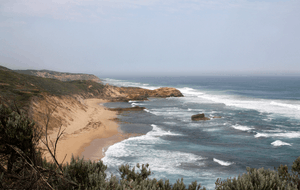
Holt again rose early on Sunday, 17 December, and after breakfast telephoned his wife. He drove to the local general store mid-morning, where he bought insect repellent, peanuts, and the weekend newspapers. One of the headlines in The Australian was "PM advised to swim less", which detailed the latest advice from Holt's doctor; however, it is unclear if Holt bought or read that particular paper. On returning home, Holt made plans for the rest of the day, which included a visit to Point Nepean, a barbecue lunch, and an afternoon spearfishing trip. At 11:15 a.m., he and four others set out for Point Nepean, where they hoped to watch solo circumnavigator Alec Rose pass through The Rip into Port Phillip Bay. He was accompanied by Marjorie Gillespie, her daughter Vyner, and two family friends of the Gillespies, Martin Simpson and Alan Stewart.[14] It was a hot day, and Rose's yacht was barely visible, so the group only stayed a short while before leaving.[15]
On the drive back to Portsea, Holt suggested that the group stop at Cheviot Beach for a swim – it was about 12:15 p.m., and he wanted to cool down and work up an appetite before lunch. Holt knew the area well and had swum there many times before, in 1960 even salvaging a porthole from the SS Cheviot, the shipwreck that had given the beach its name. Holt did not hesitate in entering the water, despite a large swell and visible currents and eddies.[15] Stewart was the only other swimmer, as the others considered it unsafe. Stewart stayed close to shore, and even in the shallows felt a strong undertow. However, Holt swam into deeper water and was dragged out to sea. The others called out to him, but he did not raise his arms or cry for help. He soon slipped under the waves and out of sight, in a manner which Marjorie Gillespie described as "like a leaf being taken out [...] so quick and final".[16]
Search
Following Holt's disappearance, Stewart drove to the nearby Officer Cadet School Portsea, an Australian Army training facility. The school was virtually deserted as most personnel were on annual leave, but the Victoria Police were contacted and initiated what became "one of the largest search operations in Australian history". The search for Holt's body began at 1:30 p.m., when three amateur divers entered the water and found it too rough.[16] They were soon joined by helicopters, watercraft, police divers, and two naval diving teams.[17] However, little progress was made, due to the rough conditions and limited equipment available. By the end of the day, there were more than 190 personnel involved, with operations based out of the Officer Cadet School;[18] this number would eventually increase to more than 340.[19]
The search resumed just before 5 a.m. on 18 December, despite strong wind, heavy seas, and occasional rain. Working in shifts, 50 divers focused on the rock pools and ledges near where Holt had last been sighted. They were forced to free dive to minimise injury, as they were continuously being driven against the nearby cliff face. Due to a change in the tide, the search was suspended at 8 a.m. and did not resume until mid-afternoon.[19] The following day's operations were again hampered by the weather.[20] Conditions improved on Wednesday, 20 December,[21] but by the following day most personnel were being withdrawn. The search for Holt's body was officially called off on 5 January 1968, although it had been gradually scaled back to the point where it consisted only of a daily beach patrol.[22] Lieutenant-Commander Phil Hawke, who led the HMAS Lonsdale diving team, would later state that "any chance of finding the prime minister was lost by the Sunday night".[20]
Aftermath
Rumours of Holt's disappearance reached the media just over an hour after it occurred,[16] and the first conclusive report was made at about 1:45 p.m., on Melbourne radio station 3DB.[17] Zara Holt was told of her husband's disappearance by Peter Bailey, one of his secretaries.[18]
Memorial service
A memorial service for Holt was held on Friday, 22 December, at St Paul's Cathedral, Melbourne. It was led by Tom Thomas, the Dean of Melbourne, with a single eulogy given by Philip Strong, the Anglican Primate of Australia. Due to the absence of a body, there were no prayers of committal. There were 2,000 attendees within the cathedral, and many thousands more lined the nearby streets and listened through a public address system.[23] Thirty newspaper reporters were given seats, but only one official photographer was allowed, as well as a single video camera at the back of the building. It was attended by the following leaders:








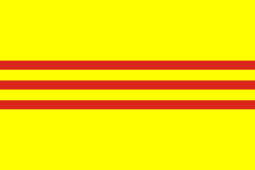


The following countries : Fiji, India, Indonesia, Japan, Laos, Malaysia, and Western Samoa sent their foreign ministers as representatives, while numerous other countries sent their ambassadors.[24]. After the service, there was a formal reception at Government House, Melbourne.[24]
Succession issues
John McEwen, the leader of the Country Party and de facto deputy prime minister, was at his farm in Stanhope, Victoria, when he was informed of Holt's disappearance. He immediately made his way to Canberra, and on the evening of 17 December met with Lord Casey, the Governor-General, at Yarralumla.[25] Casey had already conferred with Chief Justice Garfield Barwick and Attorney-General Nigel Bowen, and agreed with McEwen that he should be commissioned to form a caretaker government while the Liberal Party elected a new leader. This was based on the precedent set in 1939, when Earle Page was made temporary prime minister after the death of Joseph Lyons.[26] Casey issued a statement announcing his intentions the following day,[27] and McEwen was sworn in as prime minister on the afternoon of Tuesday, 19 December.[20]
Discussions about who would succeed Holt as leader of the Liberal Party began as soon as his disappearance became general knowledge.[28] The situation was complicated by McEwen publicly announcing that the Country Party would leave the coalition if the Liberals selected Treasurer William McMahon (the party's deputy leader).[21] The leadership election was not held until 9 January 1968, the 23rd day after the disappearance. The four candidates were John Gorton, Paul Hasluck, Billy Snedden and Les Bury. Gorton was elected over Hasluck on the second ballot, and was sworn in as prime minister the following day – the first senator to hold the office. In line with the constitutional convention that the prime minister must sit in the House of Representatives, he resigned from the Senate on 1 February to contest the by-election caused by Holt's death, which was held on 24 February. He won an easy victory, and was sworn in to the House on 12 March.[29]
Analysis
According to his biographer, Tom Frame, "there could never realistically be much doubt that Harold Holt drowned – he was simply one of the number of ordinary Australians who drown each year through poor judgment or bad luck."[30] Holt likely misjudged his own swimming ability and the roughness of the conditions, and was simply overcome by exhaustion. Alternatively, he may have suffered a heart attack, been struck by driftwood, stung by jellyfish, or attacked by a shark. Holt's body was probably either trapped below the surface or washed out to sea on the ebb tide. It was not unusual for this to occur – three men had drowned at a beach in Rye a few years earlier, with one body disappearing and the other two ending up in different places.[31] Sir Robert Southey, a senior figure in the Liberal Party's organisational wing, said of the events in a 1994 interview:
My own feeling about what happened is something like this; [Holt] was a very good swimmer, a very good snorkeler and he came back to Melbourne and troubled, not very well, overstretched, overstrained, worried I believe at the ascendancy which Whitlam was beginning to gain and thinking, 'Well now I can relax there's one area in which I really am unchallenged boss, and that's the sea.' And I think in that sort of frame of mind he went to the element where he felt liberated and misjudged the kindness with which his favourite element would receive him on that fateful day.[12]
Some have suggested that Holt entered the water primarily in order to impress Marjorie Gillespie, with whom he was rumoured to be having an affair. Zara believed that this was the case,[4] and in 1988 Gillespie publicly identified herself as Holt's lover. However, in an earlier interview she had been specifically asked if their relationship was sexual in nature, and did not characterise it as such.[32]
Formal investigations
The Victoria Police launched a formal investigation into Holt's disappearance the day after it occurred. Jack Ford, a former homicide detective, was chosen to head the investigation, with Aubrey Jackson of the Commonwealth Police assisting.[27] The resulting police report was released on 5 January 1968, but did not record any definitive findings due to a lack of evidence. Senior pathologist James McNamara was consulted about what might have happened to Holt's body, and suggested that it may have been trapped by kelp and then consumed by sea creatures (specifically sharks, crayfish, and/or sea lice). If that were the case, "the body would have been reduced to a skeleton in a period as short as 24 to 48 hours".[31] Some of those involved in the investigation later reported that certain relevant information had been deliberately omitted from the final report – for instance, Simpson's statement that Holt had had several cans of beer in his bag.[lower-alpha 1][34]
The federal government declined to conduct its own inquiry, as the disappearance was considered uncontroversial and his family did not want one.[30] Until 1985, state law did not allow for the Victorian Coroners Court to conduct an inquest without the presence of a body. In August 2003, State Coroner Graeme Johnstone announced that his office had compiled a list of 103 cold cases involving suspected drownings where bodies were never recovered.[35][36] By November 2004, 82 cases had been deemed suitable for coronial inquests, including that of Holt.[37] Johnstone opened a formal inquest in August 2005,[38] and handed down his findings early the following month. He concluded that, "Mr Holt took an unnecessary risk and drowned in rough water off Cheviot Beach [...] there is nothing of significance in any of the material gathered that would indicate anything other than drowning occurred".[39] Johnstone also criticised the decision not to hold a governmental inquiry at the time of the disappearance, suggesting that it "may have avoided the development of some of the unsubstantiated rumours and unusual theories".[40]
Suggestions of suicide
Some have advanced the view that Holt's death was not accidental, but rather that he chose to end his own life. Supporters of this theory claim that Holt was depressed and mentally unstable, and killed himself because he thought his political career was in jeopardy. Those who reject it point to his joie de vivre and commitment to his family, as well as the plans he had made for the coming year.[41] The 1968 police report specifically ruled out suicide, as Holt had followed "an ordinary domestic pattern" in the days before his disappearance, and suicides in front of witnesses were considered atypical.[32]
Who Killed Harold Holt?, a Nine Network television documentary that aired in 2007, gave particular credence to the suicide theory, as did an article in The Bulletin published the same year. In response, Holt's son Sam gave an interview in which he said "there's no mystery, in essence there's no credibility at all; no one in our family believes it"; Zara had earlier said that her husband was "too selfish" to commit suicide.[41] Two of Holt's former colleagues, Tony Eggleton and Malcolm Fraser, were also interviewed around the same time, and both rejected any suggestion of suicide; Alick Downer and James Killen had expressed similar sentiments in their memoirs.[lower-alpha 2] In contrast, Edward St John believed suicide was plausible, suggesting that Holt's death "appeared to be an act of a man who either wanted to die or didn't much care whether he lived or died".[43] Senior public servant Sir Lenox Hewitt recalled in a 1994 interview that Holt had seemed depressed in the period before his death.[12] Peter Butt, who produced the 2008 docudrama The Prime Minister is Missing, observed that "no one thought it was in his character and all those who know him dismiss the idea completely".[10]
Conspiracy theories
Holt's disappearance spawned numerous conspiracy theories, most of which involve claims of a cover-up at the highest level of government. A 1968 story in the Sunday Observer claimed that Holt had been assassinated by the CIA, supposedly because he intended to pull Australia out of Vietnam.[32] There were also suggestions that Holt had been killed by the North Vietnamese (after being incapacitated by a nerve agent),[44] or that he had faked his own death to be with a lover.[45] In 1983, British journalist Anthony Grey published The Prime Minister Was a Spy, in which he claimed that Holt was a lifelong spy for the People's Republic of China. According to Grey, Holt faked his own death in order to defect to China, and was "collected" by frogmen who dragged him to a waiting submarine. Reviewers noted multiple factual errors in the book, not least that it was physically impossible for a submarine to be positioned so close to the shore. Zara observed that her husband "didn't even like Chinese food".[46]
Legacy
Holt is remembered more for the circumstances of his death than for his political achievements. Sol Encel believed that his disappearance marked the end of an interregnum between the stability of Menzies and the internal conflict the Liberal Party experienced under Gorton and William McMahon. Australia had only one prime minister (Menzies) from 1949 to 1965, but then from 1966 to 1975 had six prime ministers.[47] Peter Bowers said that Holt's death ended Australia's "age of innocence", as it meant national leaders could no longer keep their private lives completely away from public scrutiny.[48]
Memorials
On the first anniversary of Holt's death, a commemorative plaque was bolted to a reef at Cheviot Beach, approximately 15 metres (49 ft) underwater.[49][50] There are monuments to Holt on the cliff above the beach and at the Melbourne General Cemetery, the latter featuring the inscription "he loved the sea".[51][52] In September 1968, a naval communication station in Western Australia was renamed in Holt's honour.[53] The following year, Holt's widow was invited to Los Angeles to launch the USS Harold E. Holt – one of only a handful of U.S. Navy ships named after foreign leaders.[54] In March 1969, the Harold Holt Memorial Swimming Centre was opened in suburban Melbourne. It had been under construction at the time of Holt's death, and the Malvern City Council voted to name it in his honour, in part because he had been the local member of parliament.[55] The Australian Army also dedicated a swimming pool to Holt's memory – the Harold Holt Memorial Pool at the Australian base in Vũng Tàu, Vietnam.[56]
Popular culture
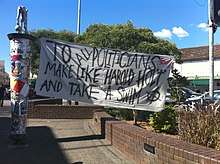
Holt's death has entered Australian folklore, and is frequently the subject of black humour.[57] Travel writer Bill Bryson labelled it "the swim that needed no towel".[58] Holt's name has become a byword for any sudden or unexplained disappearance; the phrase to do a Harold Holt is rhyming slang for to bolt (i.e., to make a quick exit).[59][60] Holt's death spawned a storyline in the Australian soap opera Neighbours, and has also been credited with inspiring The Fall and Rise of Reginald Perrin, a British television series.[61] In 1988, rugby league commentator Jack Gibson – ex-coach of the Cronulla-Sutherland Sharks – said that "waiting for Cronulla to win a Grand Final is like leaving a porch light on for Harold Holt". Over the following thirty years, opposition fans taunted Cronulla by waving posters of Holt's face and dressing up in wetsuits; the club eventually won its first premiership in 2016.[62]
Notes
- Holt did not have a reputation as a prolific drinker, and reputedly favoured cocktails rather than wine or beer.[33]
-
- Eggleton said Holt "didn't sound like a man planning to jump into the sea and end it the next day" (in reference to a phone conversation they had had on 16 December).[41]
- Fraser said "if somebody is planning to jump off a cliff, they are not at the same time planning to have a major cabinet review of the direction that Australia's taking" (in reference to plans he and Holt had discussed for 1968).[42]
- Downer said "no one who really knew Holt would lightly come to such a conclusion ... Holt was not the sort of man who would sacrifice everything for the unknown".[32]
- Killen said "there was nothing I ever saw in his make-up which would give the slightest support to the view that he could become desperate and suicidal".[43]
References
- I. R. Hancock, Holt, Harold Edward (1908–1967) Archived 2017-11-07 at the Wayback Machine, Australian Dictionary of Biography, National Centre of Biography, Australian National University, published first in hardcopy 1996, accessed online 14 September 2017.
- Frame, Tom (2005). The Life and Death of Harold Holt. Allen & Unwin. p. 149. ISBN 1-74114-672-0.
- Frame (2005), p. 219.
- Silence of Harold Holt's secret lover, Marjorie Gillespie Archived 2017-08-14 at the Wayback Machine, The Daily Telegraph, 13 September 2013. Retrieved 4 November 2017.
- Frame (2005), p. 272.
- Home movies cast angler Holt: all the way with LBJ Archived 2008-02-10 at the Wayback Machine, The Age, 1 November 2007. Retrieved 9 November 2017.
- Frame (2005), p. 273.
- Frame (2005), p. 274.
- Frame (2005), pp. 51–52.
- Harold Holt drowning under the spotlight, The Weekend Australian, 18 October 2008. Retrieved 4 November 2017.
- Frame (2005), p. 246.
- Belsham, Bruce; Clark, Tim (1994). "It's Alright Boss". The Liberals: Fifty Years of the Federal Party. Episode 2. ABC.
- Frame (2005), p. 247.
- Frame (2005), p. 248.
- Frame (2005), p. 249.
- Frame (2005), p. 250.
- Frame (2005), p. 251.
- Frame (2005), p. 252.
- Frame (2005), p. 259.
- Frame (2005), p. 262.
- Frame (2005), p. 264.
- Frame (2005), p. 265.
- Frame (2005), p. 266.
- Frame (2005), p. 267.
- Frame (2005), p. 253.
- Frame (2005), p. 254.
- Frame (2005), p. 261.
- Frame (2005), p. 255.
- Frame (2005), p. 269.
- Frame (2005), p. 295.
- Holt (2005), p. 275.
- Frame (2005), p. 277.
- Frame (2005), p. 136.
- "The mystery of Harold Holt", The Gold Coast Bulletin, 30 August 2003.
- Harold Holt may get his inquest – 36 years on Archived 2017-11-07 at the Wayback Machine, The Sydney Morning Herald, 25 August 2003. Retrieved 31 October 2017.
- Memories of the hunt for Harold Holt Archived 2017-11-07 at the Wayback Machine, The Age, 26 August 2003. Retrieved 31 October 2017.
- "Holt inquest to be held next year" Archived 2017-11-07 at the Wayback Machine, The Age, 15 November 2004. Retrieved 31 October 2017.
- Harold Holt inquest starts, 40 years on Archived 2018-02-28 at the Wayback Machine, The Sydney Morning Herald, 22 August 2005. Retrieved 31 October 2017.
- Final verdict on Holt disappearance Archived 2016-04-16 at the Wayback Machine, The Age, 2 September 2005. Retrieved 31 October 2017.
- Harold Holt drowned, coroner finds Archived 2016-05-13 at the Wayback Machine, The Sydney Morning Herald, 2 September 2005. Retrieved 31 October 2017.
- Harold Holt disappearance: 48 years on and still no answers, Herald Sun, 16 December 2015. Retrieved 11 November 2017.
- Fraser challenges Holt suicide theory, The Australian, 15 November 2007. Retrieved 11 November 2017.
- Frame (2005), p. 276.
- Frame (2005), p. 278.
- Frame (2005), p. 293.
- Frame (2005), pp. 278–292.
- Frame (2005), p. 301.
- "The death that ended our age of innocence". The Age. 31 December 2001. Archived from the original on 10 November 2017. Retrieved 9 November 2017.
- In Memory of Mr. Harold Holt Archived 2017-11-07 at the Wayback Machine, The Australian Women's Weekly, 1 January 1969.
- The little known underwater plaque for Harold Holt Archived 2018-02-28 at the Wayback Machine, ABC News, 14 February 2017. Retrieved 4 November 2017.
- Harold Holt Archived 2017-11-07 at the Wayback Machine, Monument Australia. Retrieved 4 November 2017.
- Melbourne General Cemetery Archived 2017-11-07 at the Wayback Machine, Museum of Australian Democracy. Retrieved 4 November 2017.
- HEH Naval Communication Station Archived 2017-06-06 at the Wayback Machine, Shire of Exmouth. Retrieved 4 November 2017.
- All the way, and beyond, The Weekend Australian, 4 November 2013. Retrieved 4 November 2017.
- History of Harold Holt Swim Centre Archived 2017-06-08 at the Wayback Machine, City of Stonnington. Retrieved 4 November 2017.
- Australian War Memorial Archived 2017-11-07 at the Wayback Machine. Retrieved 4 November 2017.
- "Australian humour". Australian Government. Archived from the original on 18 December 2017. Retrieved 19 December 2017.
- How to Speak Australian Archived 2017-08-28 at the Wayback Machine, The New York Times, 20 August 2000. Retrieved 9 November 2017.
- Straight to the poolroom with these Australian idioms Archived 2017-11-07 at the Wayback Machine, Oxford Australia, 10 August 2016. Retrieved 4 November 2017.
- Harold Holt does a Harry Archived 2017-11-07 at the Wayback Machine, Ozwords, 5 August 2012. Retrieved 4 November 2017.
- The swim that needed no towel ... Archived 2017-11-07 at the Wayback Machine, The Guardian, 24 August 2005. Retrieved 4 November 2017.
- Harold Holt’s grandson will cheer for Cronulla in Sunday’s NRL grand final Archived 2016-11-04 at the Wayback Machine, The Daily Telegraph, 28 September 2016. Retrieved 3 November 2017.
External links
- Commonwealth Police; Victorian Police (January 1968). "Report by the Commonwealth and Victoria Police on [the] Disappearance of the Prime Minister, the Rt Hon Harold [Edward] Holt, CH, MP, Cheviot Beach, Portsea, Victoria, Sunday, 17 December 1967. Canberra, January 1968". National Archives of Australia.—Includes eyewitness statements
